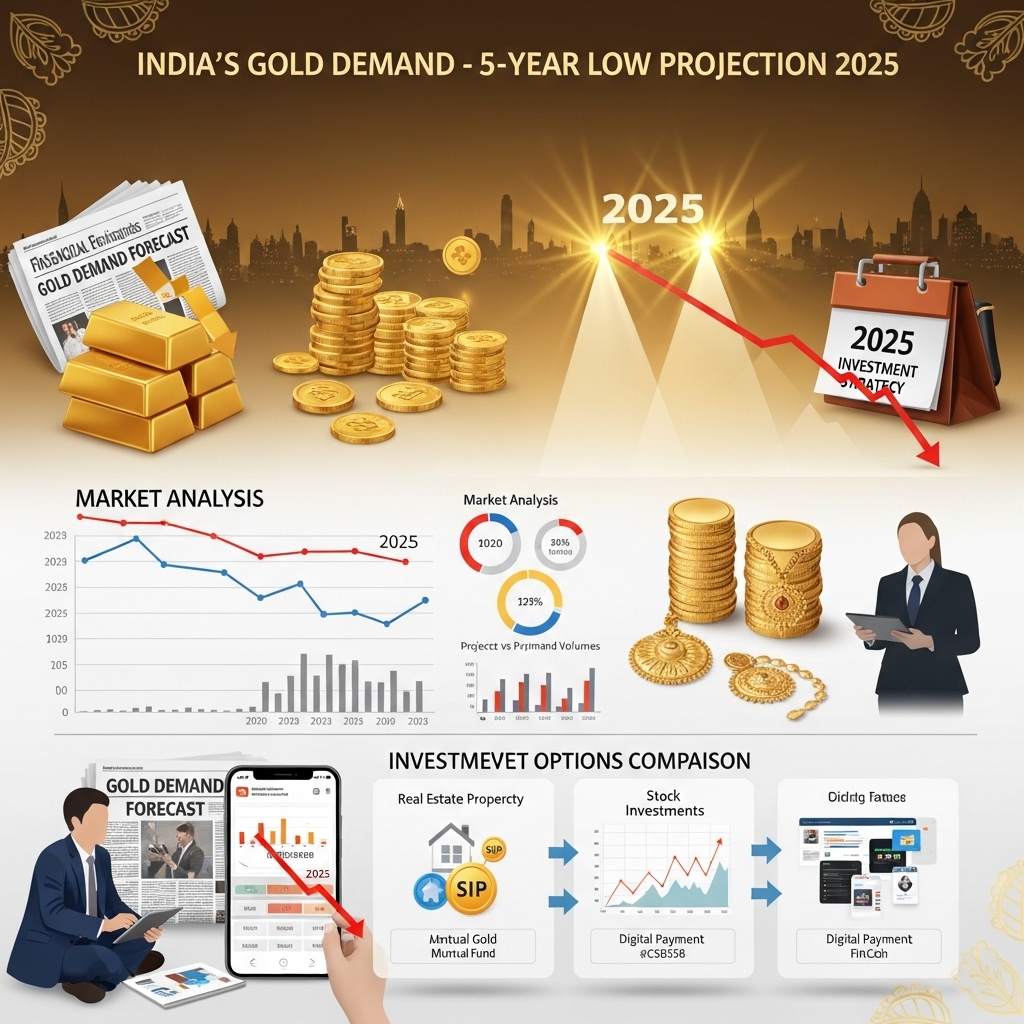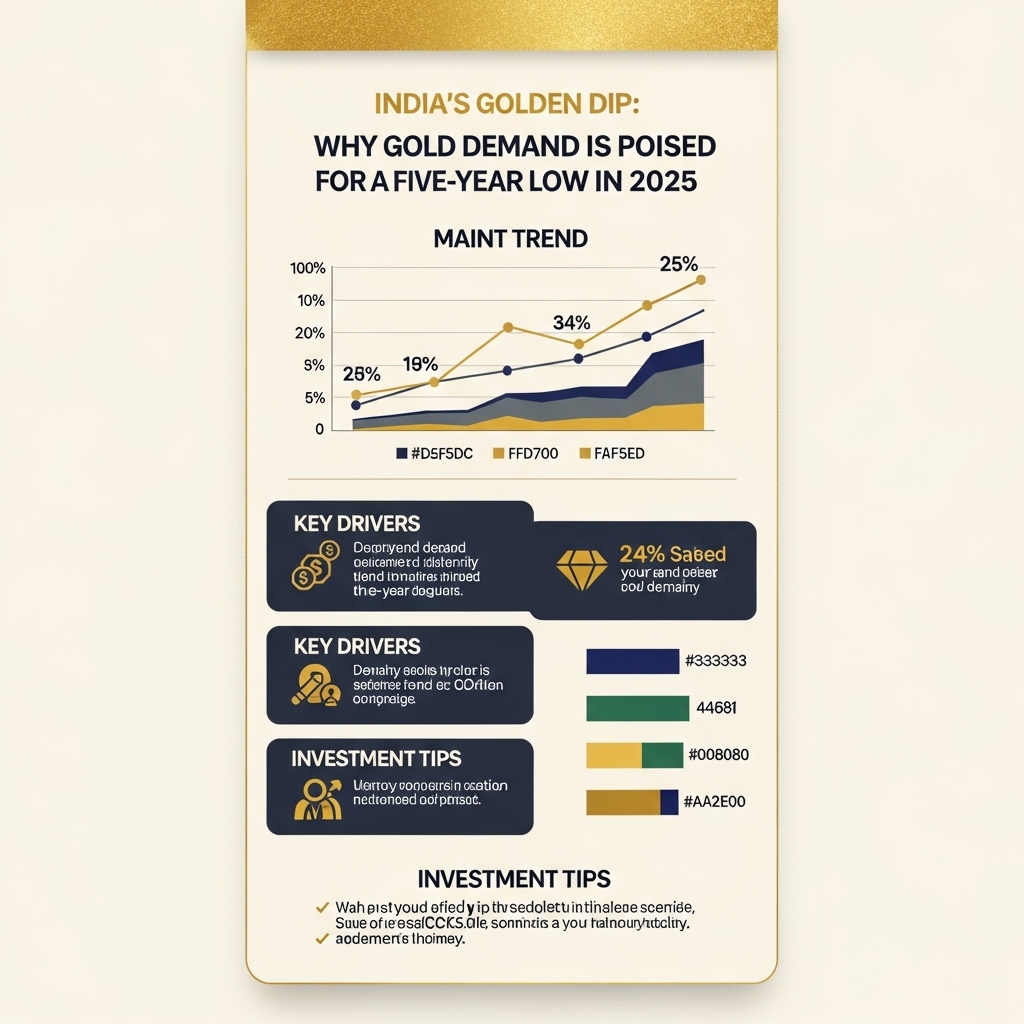India’s Gold Demand Slump: A Gold Investor’s Opportunity?
The allure of gold has captivated investors for centuries, acting as a perennial safe-haven asset and a store of value amidst economic uncertainty. However, recent forecasts suggest a significant shift in the global gold landscape, with India’s gold demand projected to hit a five-year low in 2025. This potential downturn, driven by a confluence of economic factors and changing consumer behaviors, presents a compelling narrative for astute gold investors. Understanding the forces shaping demand in one of the world’s largest gold markets is crucial for navigating the evolving market trends and identifying potential opportunities.
This post will delve into the key drivers behind this anticipated decline in Indian gold consumption. We’ll explore the impact of rising prices, government policies, and evolving consumer preferences on the demand for gold jewelry and investment. Furthermore, we will analyze how this projected slowdown in India might influence global gold prices and create unique investment avenues for those looking to capitalize on market fluctuations. For any serious gold investor, keeping a pulse on such significant market shifts is paramount to making informed decisions, protecting existing portfolios, and potentially unlocking new avenues for financial growth.
The implications of India’s reduced gold demand extend far beyond its borders, offering valuable insights for international investors. By examining the specific economic and social factors at play, we can better understand the broader dynamics affecting gold’s perceived value and investment appeal. Whether you are a seasoned gold trader or a novice looking to diversify your holdings, understanding this critical market trend is essential for staying ahead of the curve and making strategic investment choices in the dynamic world of precious metals.
Gold Market Analysis and Key Insights
India’s anticipated five-year low in gold demand for 2025, particularly impacting investment, signals a crucial shift in the nation’s financial landscape. Several interconnected factors are at play, reshaping traditional investment preferences.
Rising Gold Prices and Affordability
Globally, gold prices have surged, touching near-record highs in both international and INR terms. This elevated price point directly impacts affordability for Indian consumers and investors, who are highly price-sensitive. While gold is a traditional store of wealth, its current valuation makes substantial new investment, especially in physical form, less accessible for many, particularly in rural areas where demand is often robust.
Shifting Investment Landscape
The Indian investment environment is evolving. With the Reserve Bank of India’s assertive stance on interest rates, alternative avenues like bank fixed deposits and government bonds offer more attractive, guaranteed returns. Furthermore, a growing awareness and accessibility of equity markets and mutual funds, coupled with their potential for higher capital appreciation, are diverting investment flows that might traditionally have gone into gold.
Current Gold Market Trends and Data: As of late 2024, global gold prices hover around $2,300 per ounce, with Indian domestic prices reflecting this strength, often exceeding ₹70,000 per 10 grams. This upward trend, partly fueled by geopolitical uncertainties and central bank buying, paradoxically dampens retail investment demand in price-sensitive markets like India. Higher interest rates globally, alongside a strong US dollar, also present an opportunity cost for holding non-yielding assets like gold.
Investment Benefits and Considerations: Gold traditionally serves as a hedge against inflation and currency depreciation, offering portfolio diversification and acting as a safe-haven during economic turmoil. However, for Indian investors, key considerations include its non-yielding nature (unlike FDs or equities that offer dividends/interest), storage costs for physical gold, and potential liquidity issues. The opportunity cost of capital is significant when other asset classes offer competitive returns.
Expert Recommendations: Financial experts suggest a strategic approach to gold investment. Rather than purely physical gold, they recommend considering digital avenues like Sovereign Gold Bonds (SGBs) for their interest earnings and capital gains tax benefits, or Gold Exchange Traded Funds (ETFs) and Gold Mutual Funds for liquidity and convenience. A diversified portfolio, with gold as a tactical allocation (typically 5-10%), remains prudent for risk mitigation, but new investments should be carefully weighed against prevailing market conditions and personal financial goals.

Gold Investment Strategies and Options
For investors navigating periods of fluctuating gold demand, understanding strategic allocation is crucial. Diverse options exist, each with unique risk-reward profiles. Physical gold, such as coins and bars, offers tangible asset security and traditional appeal but involves storage, insurance costs, and less liquidity. Alternatively, Digital Gold platforms and Gold Exchange Traded Funds (ETFs) provide convenient, liquid exposure without physical custody concerns, simplifying transactions and enabling smaller investments. A particularly attractive option for Indian investors is the Sovereign Gold Bond (SGB) scheme, which offers regular interest payments, a sovereign guarantee, and tax exemptions on redemption, though liquidity before maturity can be limited. Indirect exposure can also be gained through gold mining stocks, offering potential leverage to gold price movements but carrying company-specific risks.
Gold typically serves as a crucial portfolio diversifier and a hedge against inflation, currency devaluation, and geopolitical uncertainty. A common portfolio allocation strategy ranges from 5-15% of total assets, depending on an investor’s risk tolerance and economic outlook. While gold offers stability, it’s susceptible to price volatility, influenced by interest rates, the strength of the US dollar, and global economic sentiment.
Comparing these methods, physical gold appeals to those seeking tangible assets, while ETFs/digital gold offer convenience and lower overheads. SGBs uniquely combine market-linked returns with government backing and income. Regarding market timing, a projected five-year low in India’s gold demand by 2025 could signal attractive entry points if prices reflect this subdued demand. Long-term investors might consider dollar-cost averaging to mitigate short-term price fluctuations, emphasizing gold’s role as a long-term store of value and wealth preservation tool rather than a purely speculative asset.
Market Performance and Outlook
India’s gold demand, a global bellwether, has historically been robust, often fluctuating with economic cycles and cultural drivers. In recent years, while demand has remained substantial—with 2023, for instance, seeing significant purchases despite rising prices—it hasn’t reached the pre-pandemic peaks that characterize earlier periods of high growth.
Currently, the market faces multiple headwinds. Domestic gold prices are at record highs, driven by strong global bullion rates and a depreciating Indian Rupee, which makes imports costlier. This, coupled with persistent inflation, is eroding consumer purchasing power, particularly in rural areas which constitute a large portion of demand. Moreover, higher domestic interest rates are making alternative investments like fixed deposits and equities relatively more attractive, diverting funds away from gold.
Looking ahead to 2025, India’s gold demand is indeed tipped to hit a five-year low. This outlook is predicated on a confluence of factors: sustained high gold prices globally, potentially continued rupee weakness, and an evolving investment landscape where younger demographics may increasingly favor financial assets. Economic growth might not translate directly into gold demand if inflationary pressures persist and rural incomes remain stagnant or grow slowly.
Several critical economic factors influence gold prices and demand. Globally, U.S. Federal Reserve monetary policy, the strength of the U.S. dollar, and geopolitical uncertainties are key drivers for international gold prices. Domestically, the Rupee’s depreciation against the dollar directly impacts import costs. Inflation levels, interest rate policies set by the RBI, and government import duties also significantly shape the affordability and attractiveness of gold in the Indian market.
Frequently Asked Questions About Gold Investment
Why is India’s gold demand projected to reach a five-year low in 2025?
This forecast is primarily driven by persistently high gold prices, making it less affordable for average consumers. Economic slowdowns impacting disposable income, evolving consumer preferences shifting away from traditional physical gold, and the continued effect of government policies like import duties are also significant contributing factors.
How might reduced Indian demand influence global gold prices?
While India is a major gold consumer, global gold prices are influenced by a multitude of factors, including U.S. interest rate policies, geopolitical stability, and central bank buying. Reduced Indian demand might exert some minor downward pressure or cap upward price movements, but it’s unlikely to be the sole determinant of global price trends.
Should existing gold investors in India be worried by this forecast?
Not necessarily. Gold traditionally serves as a long-term store of value and a hedge against inflation. Short-term demand fluctuations are normal market dynamics. Existing investors should focus on their long-term financial objectives rather than reacting to short-term market shifts or demand forecasts.
What does this trend imply for new gold investments in India?
A projected dip in demand could potentially create buying opportunities if it leads to more attractive gold prices. However, new investors should still perform thorough due diligence. Gold should be considered as part of a diversified investment portfolio, aligned with individual risk tolerance and investment horizons.
Are government policies playing a role in this anticipated decline?
Yes, government policies, particularly the imposition of high import duties on gold, directly increase its cost for domestic consumers, thereby discouraging purchases. Other regulatory changes or taxation policies related to gold can also significantly influence consumer and investor behavior in the market.

Final Thoughts on Gold Investment
As we’ve explored, India’s gold demand faces headwinds, with a projected five-year low in 2025. For gold investors, this means navigating a potentially softer market influenced by global economic shifts and domestic factors like interest rate hikes and a strong rupee. While short-term demand may be subdued, the long-term appeal of gold as a safe-haven asset and inflation hedge remains. We advise a cautious approach, focusing on diversification and potentially using any price dips as opportunities to accumulate gold for the long haul, rather than speculating on short-term gains. Keep a close eye on economic indicators and consider consulting a financial advisor to align your gold holdings with your overall investment strategy. What are your thoughts on India’s gold market outlook? Share your insights in the comments below!